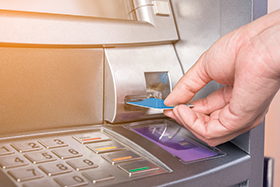

As with most security system applications, a combination of manpower, physical barriers and technology provides the best approach to the commonly recognised ‘deter, detect and defend’ philosophy.
Francois Smuts, key accounts support manager at Elvey Group, says that there are typically four pillars that need to be addressed with regard to security in the financial sector: retail banking halls, offsite ATMs, properties owned by FSPs and cash centres. Each of these, he says, have very different risk profiles and therefore need a customised approach to designing and deploying security technology solutions.
“This you could consider as your local bank, which has various subsets within the main building structure, including ATMs, the back office, cash receiving and cash storage. The security focus here is on customers being able to access the banking hall as well as the ATMs, with access to the other areas being carefully controlled,” says Smuts.
A security system in this environment is aimed at protecting both bank clients and staff. The approach during working hours would be to reduce any potential panic situations by monitoring the entire environment for predefined unusual behaviour.
In the banking hall and ATM subsections, CCTV cameras would typically form the mainstay of this solution and be linked to video analytics for comprehensive detection of the aforesaid behavioural anomalies. “Typically, one would use an offsite facility to monitor the movement of people and equipment and detect behaviour such as loitering. Video verification would be used to ascertain the veracity and legitimacy of an incident,” says Smuts.
Access control into banking halls can be approached with either an open-door policy or with the inclusion of a man-trap cubicle, which often contains a small CCTV camera used to provide both security for all banking hall users as well as safety for people within the cubicle should they for some reason become trapped in the cubicle. Once inside the banking hall, access to back offices, cash collections areas and other high-risk areas could be controlled with fingerprint, iris and facial recognition technology and be complemented by double and triple locking solutions armed with time delays.
Smuts explains that the after-hours scenario is very different to daytime security, with the focus being predominantly on intrusion detection. “We see typical deployments of alarm systems that detect intrusion via the building’s roof, as well as on external perimeter doorways. In addition, in vaults seismic detection solutions have become more commonplace and are attuned to vibrations that result from impact (hammering) and drilling activities.”
Protecting the cash within an offsite ATM could involve the deployment of deterrent devices designed to disorientate the intruder. This would be complemented by some form of panic alert that can be activated in a number of ways specific to the particular bank. All of these technologies would be linked back to a 24-hour control room, via at least three forms of failsafe communications to ensure consistent and constant relay of event activities, thereby allowing the remote monitoring team to alert armed response teams for further remedial action.
“There is a big difference between protecting an ATM within a banking mall and one that is offsite, since the onsite ATM closes after-hours and is therefore protected as part of the general banking hall and vault security portfolio. Offsite ATM risk management at 24-hour facilities, such as garages, carries a different risk profile and is often managed by a different team to the one managing the banking hall ATMs,” says Smuts.
In essence, an offsite ATM is a bank’s offsite vault and requires a higher level of security constant than its onsite partner. “The main focus here is to prevent access to the ATM’s small back room, thereby preventing the illegal removal of cash. The key to success here is early detection of criminal activity and this can be achieved by deploying various technologies that work together synergistically,” says Smuts.
In addition, remote monitoring on the ‘business side’ of the ATM will help to protect ATM users. The presence of loiterers could be a possible indication of attempted tampering with the ATM itself or of card cloning/skimming of ATM users’ bank cards. “Providing an interface via artificial intelligence (AI), linked to a reputable CCTV surveillance product, is the preferable solution,” says Smuts.
Smuts says that the protection of buildings owned by a financial service provider is similar to the protection of any other commercial building occupied by people and focuses on the safety of these people by monitoring the natural movement of people in and out of the building and within its confines.
The security of cash centres, on the other hand, is often incorporated into the duties of a cash guarding/cash-in-transit service company. “Here we would see the deployment of more CCTV cameras possibly coupled with seismic detection technology which monitor the movement and access of people, vehicles and assets in these high-risk units. High-end access control and intrusion solutions are commonplace and are focused on the protection of the cash itself,” says Smuts.
The Elvey Group has a portfolio of security and aligned communications technology solutions which can be combined to provide a formidable barrier against crime in the financial services sector. “Our team leverages extensive experience in the sector to provide bespoke solutions that match the exact parameters defined by our banking clients,” Smuts points out.
| Tel: | +27 11 401 6700 |
| Email: | [email protected] |
| www: | www.elvey.co.za |
| Articles: | More information and articles about Elvey Security Technologies |
© Technews Publishing (Pty) Ltd. | All Rights Reserved.